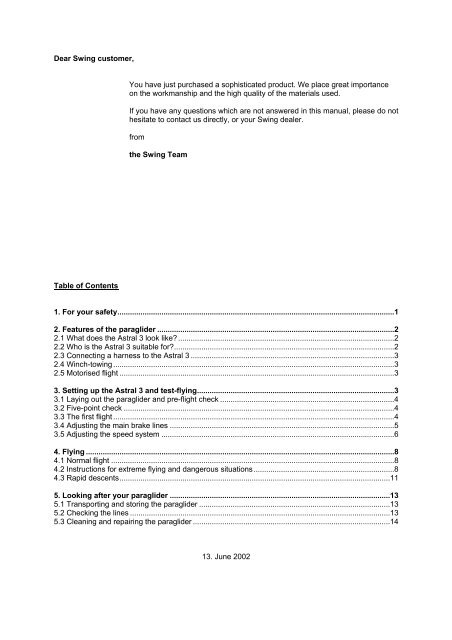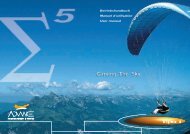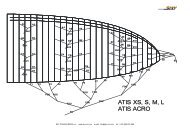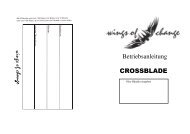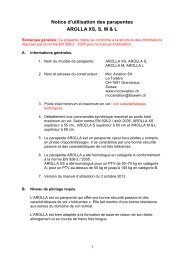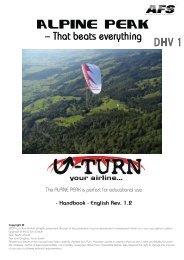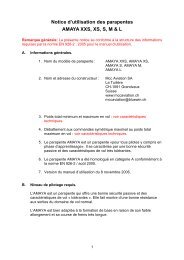Boxtair Betriebsanleitung - Free
Boxtair Betriebsanleitung - Free
Boxtair Betriebsanleitung - Free
You also want an ePaper? Increase the reach of your titles
YUMPU automatically turns print PDFs into web optimized ePapers that Google loves.
3.5 Adjusting the speed systemAlthough the Astral 3 is already trimmed to a sufficiently high basic speed, it is also equipped with aspeed system. You will use it in particular if there is a strong headwind, when you fly over valleys or ifyou want to leave a dangerous area quickly.Speed system fixedat the riserFunctionThe A-, B- and C-risers can be shortened by using the speed bar. This decreases thecanopy's angle of attack.Diagramleft:unacceleratedright:accelerated6
4. FLYING4.1 Normal flightLaunchPull the Astral 3 up ensuring your arms and the lines are down and behind you (even ifthere is no wind). Hold both the inner A-risers, without shortening them too much. TheAstral 3 launches very smoothly and is easy to control. Launching is even easier if thecanopy is arranged in a half-moon shape.Level flightThe Astral 3s flight is stable and level when the brakes are up.TurnsThe Astral 3 performs best in turns when it is flown with sufficient speed. Too muchbraking increases the sink rate unnecessarily.The glider has no negative tendency.LandingStart pulling down the brakes as far as they will go when you are approximately 1 to 2meters above the ground, so that the paraglider has been fully braked just before theground is reached. The Astral 3 can be landed without any problem.Caution! Accident risk!Always fly with sufficient speed when you are near the ground (well above the stallspeed).4.2 Instructions for extreme flying and dangerous situationsSources ofdangerThere are no problems during a normal flight. However, pilot error during the flight orextreme wind conditions may leave the wing in an unusual flying position. This mayrequire the pilot to make corrections during flight to which he is unaccustomed.In this section we explain how to correct any extreme situations you may get into. Wealso describe how the Astral 3 reacted in simulations during test-flights.TipThese instructions do not replace safety training or specialised literature. Werecommend that you undertake special safety training which will prepare you forextreme situations.Caution! Accident risk!Always keep within the recommended limits. Do not perform aerobatics or extremeflying manoeuvres, such as spirals with "big ears". This will prevent accidents causedby over-loading the glider.8
Deep stallVarious things can cause a paraglider to deep stall, e.g. shrinkage of the C and D linesas a result of dampness or flying in the rain. The airflow from the front of the glidergradually breaks away towards the back and the canopy sags, with the glider remainingupright. Paragliders are particularly susceptible to deep stalls if the wing loading is toolow.C and D lines which are too short, for example, can often be recognised because launchbehaviour deteriorates.You can recognise a deep stall because there is less flight noise than normal. Inaddition, your sink rate will increase (4-5 m/s).RecoveryRemain in an upright position and push the A- and B-risers in the direction you are flying,so as to shorten them by 5 to 10 cm.If you have a speed system, simply use it to accelerate.Caution! Accident risk!The minimum flight speed increases when there is rain or line shrinkage. This meansthat you must be very careful when using the brakes.Front StallStrong turbulence can cause part or all of the leading edge of the glider to fold or tuckunder.Normally the Astral 3 will immediately recover its normal flight position.RecoveryIf the Astral 3 does not immediately recover from a frontal tuck, brake quickly andstrongly with both steering-lines (brake lines) to re-inflate the glider.AsymmetrictucksIf there is turbulence, one side of the paraglider may collapse. Some of the cells deflateand the paraglider could collapse or spin.During test flights the Astral 3 self-recovered on release of the A-risers which were pulleddown and caused the collapse.Recovery‣ Counter-brake slightly on the side of the paraglider that is still inflated to stop itturning away and to stabilise it.‣ Counter-brake just enough that the paraglider continues to fly straight ahead.‣ If the wing has not yet self-recovered, pump with the brake on the side that hascollapsed in order to open it, making use of the full braking distance. "Shaking" isnot enough.Caution! Accident risk!Counter-braking too strongly can result in a stall on the inflated side.9
Full stallA fullstall occurs if full brake is applied during the flight. The paraglider slows down,surges backwards and deflates. If the brakes are held down, the canopy comes upover the pilot again. The result is an almost vertical descent with a sink rate of about8m/s.Recovery Fully release the brakes within 3 seconds. If you release the brakes too slowly, theparaglider may spin. The spin stops automatically when the brakes are releasedcompletely.Caution! Accident risk!If the canopy has gone backwards, you must hold the brakes down. Otherwise thecanopy can surge forward and, in an extreme case, end up underneath the pilot. Holdthe brakes down until the canopy is above you again.SpinRecoverySpins occur when one side of the canopy stalls. The stalled part of the canopycontinues to fly forward while the other side turns in the opposite direction.Quickly release the brakes.TipIf the spin does not stop:1. Check whether you have released the brakes fully.2. If this does not work, use your reserve.Caution! Accident risk!In strong turbulence, always keep far enough away from rock faces and otherobstacles. You need time and enough height to recover from extreme situations.10
4.3 Rapid descentsIn some situations you need to lose height quickly to avoid dangerous situations, e.g. the upcurrentfrom a cumulus cloud, an approaching cold front, a storm front etc. Below we explain three ways tomake a rapid descent, so that you can avoid these situations and similar ones.Spiral dives The spiral dive is the classic method for making a rapid descent with a sink rate of up to14 m/s in normal flight situations, and up to 20 m/s in extreme flight situations. It isparticularly suitable where there is a high ascent rate and little wind. Spiral dives with asink rate above 14 m/s are not tested on certification; this exceeds the manufacturer'slimits.Starting themanoeuvreWhilst flying at full speed, start to apply the brake on one side. This will steer theparaglider into a turn with a strong bank. You can tell that you are in a spiral dive if youare being pressed hard against your seat (high centrifugal force).When you are in a spiral dive, you should steer very carefully because the paragliderwill react immediately. Banking and rate of turn increase if braking efficiency increases.Look down before and during a spiral dive so that you can tell how far you are from theground!TipWhen you are in a spiral dive, the outer part of the wing can collapse, but this is nocause for concern. You can avoid this by braking slightly in the outside of the turn.Release the brakes carefully.RecoveryIf you release the brakes too quickly, the increased speed can cause the wing to climb,become unsettled, or partly collapse.If the glider does not stop turning, you can stop it by weight-shifting to the outside ofthe turn.Caution! Accident risk!‣ With spiral dives, very high turn speeds can be reached, with an increase ofthe acceleration due to gravity. So be careful when you try this!‣ Do not continue the spiral dive too long; you could lose consciousness.‣ Never attempt this with less than 150 to 200 meters ground-clearance.‣ Spiral dives with "big ears" lead to extreme loading of the open section of thecanopy. This move is prohibited in Germany.11
B-line stallThe B-line stall is another way to descend rapidly and has a sink rate of approximately8 m/s. It is suitable where there is an average ascent rate and little wind.Starting themanoeuvreGrasp both of the B-risers at the coloured mark. Pull both of them slowly and evenlytowards your chest until the airflow is gone and the wing goes into a vertical descentflight mode. The B-risers should then be held in the same position to ensure a gentledescent.Check before and during the B-line-stall that the airspace beneath you is free.RecoveryReturn the B-risers to their normal position quickly and evenly. If you put the B-risersback too slowly, a deep stall or negative spin could occur.Caution! Accident risk!The canopy speeds up after the B-risers have been released. Under no circumstancesshould you apply the brakes at this time.TipIf the paraglider does not speed up immediately because recovery is too slow or forsome other reason, accelerate using the speed system or pull the A-risers forwards.Big ears"Big ears" is another way to descend quickly and has a sink rate of approximately 3 to5 m/s. The forward speed stays the same. You can use the "big ears" method togetherwith the speed system. It is suitable for avoiding a dangerous situation where there arehigh ascent rates and strong wind.Starting themanoeuvreRecoveryPull both outer A-risers downwards. You can now descend safely on the stable middlepart of the wing. Steer by weight-shifting The brakes must not be applied during themanoeuvre, e.g. by wrapping the brakes.Let go of both A-risers. If the ears do not open automatically, assist the openingprocess by pumping the brakes.Caution! Accident risk!When the technique of "big ears" is used, there is a higher load for the line groupswhich are still weight-bearing. Do not fly any extreme manoeuvres with "big ears".12
5. LOOKING AFTER YOUR PARAGLIDER5.1 Transporting and storing the paragliderTransportAlways transport your paragliding equipment in the special backpack and/or in theinner bag.StoringStore all of your paragliding equipment away from UV light in a dry room which is wellairedand has a constant temperature. Open the backpack and/or inner bag and thebelt a little so that air can get in.Tip‣ Sunlight, warmth and humidity can damage your equipment.‣ Temperatures lower than 10°C and higher than 50°C can make the wing unfitto fly. The manufacturer's warranty will not apply if the paraglider is not storedat the correct temperature.‣ Never store a paraglider which was packed up while still wet.If the paraglider gets wet, spread it out so that air reaches all parts of it. Since thefibres absorb water, it can take several days until it is completely dry. If a paraglider isstored wet, it can become unsuitable for flying after a short time.5.2 Checking the linesMeasuringMeasuring the length of the lines is part of the regular inspection.The lines must be measured with a load of 5kg to get comparable results. You will findthe original line measurements in the service papers.Have your paraglider checked every two years by the manufacturer or an authorisedinspector. In Germany, pilots have been able to carry out the inspection themselvessince 01.07.2001 provided that they follow all of the requirements. This is laid down bythe German "Gütesiegel” certification.TipWe recommend an inspection every 50 to 100 flight hours or once a year.13
5.3 Cleaning and repairing the paragliderCleaningOnly clean the paraglider with a soft sponge and clean water.TipHarsh chemical substances, high-pressure cleaners or steamers will destroy the surfacelayer. Clean the paraglider only if it is absolutely necessary.RepairsRepairs should only be carried out by the manufacturer or a specialist recommended bythe manufacturer.You can repair small tears in the wing yourself (not at the seams) using self-adhesivesail material, as long as they are in places which do not bear heavy loads and they arenot bigger than 3 cm.TipAlways replace lines that are damaged.If you need to replace damaged or worn-out parts, use only original parts or parts thathave been authorised by the manufacturer.We hope you have fun and many enjoyable flightsThe Swing Team14


